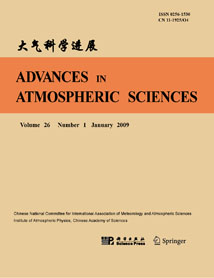| [1] |
Zhongfeng XU, Ying HAN, Meng-Zhuo ZHANG, Chi-Yung TAM, Zong-Liang YANG, Ahmed M. EL KENAWY, Congbin FU,
2024: Assessing the Performance of a Dynamical Downscaling Simulation Driven by a Bias-Corrected CMIP6 Dataset for Asian Climate, ADVANCES IN ATMOSPHERIC SCIENCES, 41, 974-988.
doi: 10.1007/s00376-023-3101-y
|
| [2] |
Donglin GUO, Huijun WANG,
2016: Comparison of a Very-fine-resolution GCM with RCM Dynamical Downscaling in Simulating Climate in China, ADVANCES IN ATMOSPHERIC SCIENCES, 33, 559-570.
doi: 10.1007/s00376-015-5147-y
|
| [3] |
Gao Xuejie, Zhao Zongci, Ding Yihui, Huang Ronghui, Filippo Giorgi,
2001: Climate Change due to Greenhouse Effects in China as Simulated by a Regional Climate Model, ADVANCES IN ATMOSPHERIC SCIENCES, 18, 1224-1230.
doi: 10.1007/s00376-001-0036-y
|
| [4] |
GAO Xuejie, LUO Yong, LIN Wantao, ZHAO Zongci, Filippo GIORGI,
2003: Simulation of Effects of Land Use Change on Climate in China by a Regional Climate Model, ADVANCES IN ATMOSPHERIC SCIENCES, 20, 583-592.
doi: 10.1007/BF02915501
|
| [5] |
Deniz BOZKURT, David H. BROMWICH, Jorge CARRASCO, Keith M. HINES, Juan Carlos MAUREIRA, Roberto RONDANELLI,
2020: Recent Near-surface Temperature Trends in the Antarctic Peninsula from Observed, Reanalysis and Regional Climate Model Data, ADVANCES IN ATMOSPHERIC SCIENCES, 37, 477-493.
doi: 10.1007/s00376-020-9183-x
|
| [6] |
Peihua QIN, Zhenghui XIE, Jing ZOU, Shuang LIU, Si CHEN,
2021: Future Precipitation Extremes in China under Climate Change and Their Physical Quantification Based on a Regional Climate Model and CMIP5 Model Simulations, ADVANCES IN ATMOSPHERIC SCIENCES, 38, 460-479.
doi: 10.1007/s00376-020-0141-4
|
| [7] |
Wei Helin, Wang Wei-Chyung,
1998: A Regional Climate Model Simulation of Summer Monsoon over East Asia: A Case Study of 1991 Flood in Yangtze-Huai River Valley, ADVANCES IN ATMOSPHERIC SCIENCES, 15, 489-509.
doi: 10.1007/s00376-998-0027-3
|
| [8] |
LI Jiandong, LIU Yimin, WU Guoxiong,
2009: Cloud Radiative Forcing in Asian Monsoon Region Simulated by IPCC AR4 AMIP Models, ADVANCES IN ATMOSPHERIC SCIENCES, 26, 923-939.
doi: 10.1007/s00376-009-8111-x
|
| [9] |
Jing ZOU, Zhenghui XIE, Chesheng ZHAN, Feng CHEN, Peihua QIN, Tong HU, Jinbo XIE,
2019: Coupling of a Regional Climate Model with a Crop Development Model and Evaluation of the Coupled Model across China, ADVANCES IN ATMOSPHERIC SCIENCES, 36, 527-540.
doi: 10.1007/s00376-018-8160-0
|
| [10] |
SHI Xueli, XIE Zhenghui, LIU Yiming, YANG Hongwei,
2007: Implementation of a Surface Runoff Model with Horton and Dunne Mechanisms into the Regional Climate Model RegCM_NCC, ADVANCES IN ATMOSPHERIC SCIENCES, 24, 750-764.
doi: 10.1007/s00376-007-0750-1
|
| [11] |
Liu Huaqiang, Qian Yongfu, Zheng Yiqun,
2002: Effects of Nested Area Size upon Regional Climate Model Simulations, ADVANCES IN ATMOSPHERIC SCIENCES, 19, 111-120.
doi: 10.1007/s00376-002-0038-4
|
| [12] |
DING Yihui, SHI Xueli, LIU Yiming, LIU Yan, LI Qingquan, QIAN Yongfu, MIAO Manqian, ZHAI Guoqing, GAO Kun,
2006: Multi-year Simulations and Experimental Seasonal Predictions for Rainy Seasons in China by Using a Nested Regional Climate Model (RegCM NCC). Part I: Sensitivity Study, ADVANCES IN ATMOSPHERIC SCIENCES, 23, 323-341.
doi: 10.1007/s00376-006-0487-2
|
| [13] |
CHEN Feng, and XIE Zhenghui,
2013: An evaluation of RegCM3_CRES for regional climate modeling in China, ADVANCES IN ATMOSPHERIC SCIENCES, 30, 1187-1200.
doi: 10.1007/s00376-012-2114-8
|
| [14] |
ZENG Xinmin, LIU Jinbo, MA Zhuguo, SONG Shuai, XI Chaoli, WANG Hanjie,
2010: Study on the Effects of Land Surface Heterogeneitiesin Temperature and Moisture on Annual Scale Regional Climate Simulation, ADVANCES IN ATMOSPHERIC SCIENCES, 27, 154-163.
doi: 10.1007/s00376-009-8117-4
|
| [15] |
Lei WANG, Qing BAO, Wei-Chyung WANG, Yimin LIU, Guo-Xiong WU, Linjiong ZHOU, Jiandong LI, Hua GONG, Guokui NIAN, Jinxiao LI, Xiaocong WANG, Bian HE,
2019: LASG Global AGCM with a Two-moment Cloud Microphysics Scheme: Energy Balance and Cloud Radiative Forcing Characteristics, ADVANCES IN ATMOSPHERIC SCIENCES, , 697-710.
doi: 10.1007/s00376-019-8196-9
|
| [16] |
Gao Xuejie, Zhao Zongci, Filippo Giorgi,
2002: Changes of Extreme Events in Regional Climate Simulations over East Asia, ADVANCES IN ATMOSPHERIC SCIENCES, 19, 927-942.
doi: 10.1007/s00376-002-0056-2
|
| [17] |
XIN Yufei, Annette RINKE, BIAN Lingen, Klaus DETHLOFF, XIAO Cunde, Moritz MIELKE,
2010: Climate and Forecast Mode Simulations for Antarctica: Implications for Temperature and Wind, ADVANCES IN ATMOSPHERIC SCIENCES, 27, 1453-1472.
doi: 10.1007/s00376-010-9178-0
|
| [18] |
DING Yihui, LIU Yiming, SHI Xueli, LI Qingquan, LI Qiaoping, LIU Yan,
2006: Multi-Year Simulations and Experimental Seasonal Predictions for Rainy Seasons inChina byUsing a Nested Regional ClimateModel (RegCM NCC) Part II: The Experimental Seasonal Prediction, ADVANCES IN ATMOSPHERIC SCIENCES, 23, 487-503.
doi: 10.1007/s00376-006-0323-8
|
| [19] |
CAO Lijuan, DONG Wenjie, XU Yinlong, ZHANG Yong, Michael SPARROW,
2007: Validating the Runoff from the PRECIS Model Using a Large-Scale Routing Model, ADVANCES IN ATMOSPHERIC SCIENCES, 24, 855-862.
doi: 10.1007/s00376-007-0855-6
|
| [20] |
Xianghui KONG, Aihui WANG, Xunqiang BI, Dan WANG,
2019: Assessment of Temperature Extremes in China Using RegCM4 and WRF, ADVANCES IN ATMOSPHERIC SCIENCES, 36, 363-377.
doi: 10.1007/s00376-018-8144-0
|















 AAS Website
AAS Website 
 AAS WeChat
AAS WeChat 
 DownLoad:
DownLoad: